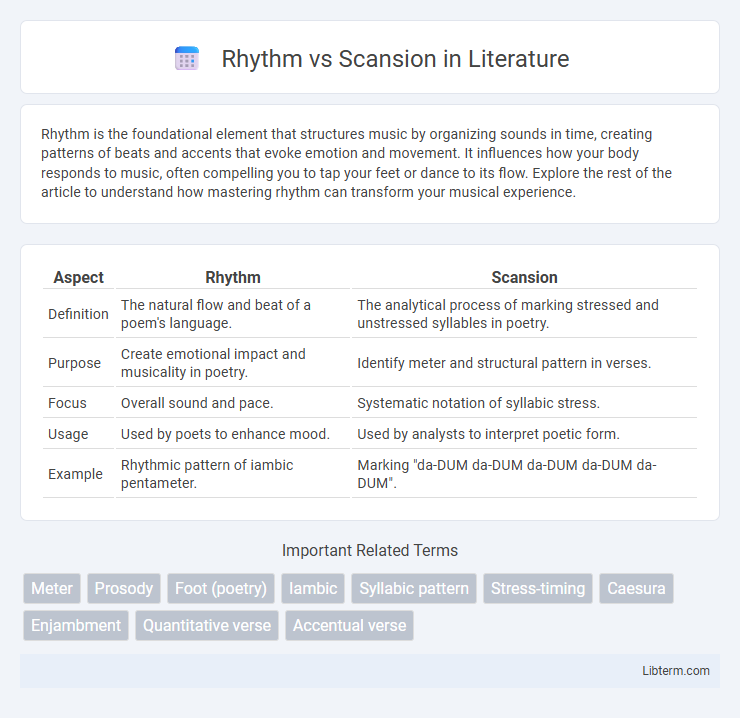Rhythm is the foundational element that structures music by organizing sounds in time, creating patterns of beats and accents that evoke emotion and movement. It influences how your body responds to music, often compelling you to tap your feet or dance to its flow. Explore the rest of the article to understand how mastering rhythm can transform your musical experience.
Table of Comparison
| Aspect | Rhythm | Scansion |
|---|---|---|
| Definition | The natural flow and beat of a poem's language. | The analytical process of marking stressed and unstressed syllables in poetry. |
| Purpose | Create emotional impact and musicality in poetry. | Identify meter and structural pattern in verses. |
| Focus | Overall sound and pace. | Systematic notation of syllabic stress. |
| Usage | Used by poets to enhance mood. | Used by analysts to interpret poetic form. |
| Example | Rhythmic pattern of iambic pentameter. | Marking "da-DUM da-DUM da-DUM da-DUM da-DUM". |
Understanding Rhythm in Poetry
Rhythm in poetry refers to the natural flow and beat created by the arrangement of stressed and unstressed syllables, shaping the poem's musicality and emotional impact. Understanding rhythm involves recognizing patterns of sound and emphasis that convey mood and pace, distinct from scansion, which is the formal analysis of these patterns. Mastery of rhythm enhances a poet's ability to craft verses that resonate with readers through sound and movement.
Defining Scansion: A Poetic Tool
Scansion is a poetic tool used to analyze the rhythm of a poem by marking the stressed and unstressed syllables within each line, revealing its metrical pattern. It helps poets and readers understand the underlying structure, such as iambic pentameter or trochaic tetrameter, that shapes the poem's rhythm. By breaking down verse into feet and stresses, scansion provides a systematic approach to exploring how sound and meaning interact in poetry.
Core Differences Between Rhythm and Scansion
Rhythm refers to the natural flow and pattern of sounds in poetry, characterized by the arrangement of stressed and unstressed syllables. Scansion is the analytical process used to identify and mark these stress patterns, helping to reveal the poem's metrical structure. Core differences lie in rhythm being the auditory experience of timing and beats, whereas scansion is a visual and technical method for studying that pattern.
The Role of Meter in Rhythm
Meter serves as the structural framework that organizes rhythm in poetry by establishing a consistent pattern of stressed and unstressed syllables. This rhythmic pattern, created through meter, enhances the musical quality and emotional impact of the poem. Scansion is the analytical process used to identify the meter, revealing how variations in stress influence the overall rhythm.
Techniques for Scanning a Poem
Techniques for scanning a poem involve identifying its metrical patterns by marking stressed and unstressed syllables, typically using symbols like V for unstressed and ' for stressed beats. Scansion requires analyzing the poem's rhythmical structure to determine the meter, such as iambic pentameter or trochaic tetrameter, by counting syllables in each line and noting variations. Understanding these techniques aids in uncovering the underlying rhythmic framework that shapes the poem's musicality and emotional impact.
Why Rhythm Matters in Poetry
Rhythm in poetry establishes the foundational beat that guides readers through the emotional landscape and enhances memorability. Unlike scansion, which is the analytical process of identifying metrical patterns, rhythm creates an immersive experience by naturally influencing pacing and tone. The strategic use of rhythm highlights key themes and evokes mood, making poetic expression more impactful and resonant.
Visualizing Poetic Scansion: Symbols and Patterns
Visualizing poetic scansion involves using specific symbols like stressed (') and unstressed (V) marks to represent the rhythm within a line of poetry, revealing its metrical structure. These patterns, such as iambic or trochaic feet, guide the reader in understanding the intended flow and emphasis of the poem. Scansion highlights the deliberate interplay between rhythm and meter, enhancing the appreciation of a poem's sonic qualities.
Common Mistakes in Rhythm vs Scansion
Common mistakes in rhythm include misplacing stressed and unstressed syllables, disrupting the natural flow of the poem. In scansion, errors often arise from incorrect identification of metrical feet or overlooking variations such as substitutions and elisions. Confusing rhythm with scansion leads to inaccurate analysis, as rhythm pertains to the poem's natural beat while scansion systematically marks metrical patterns.
The Impact of Rhythm and Scansion on Meaning
Rhythm shapes the natural flow and emotional tone of a poem, influencing how readers perceive meaning through patterns of stressed and unstressed syllables. Scansion, the methodical analysis of these rhythmic patterns, reveals underlying metric structures that deepen interpretation and highlight nuances in meaning. Understanding both rhythm and scansion enhances comprehension of a poem's expressive power, showing how sound patterns reinforce thematic elements.
Practical Tips for Analyzing Rhythm and Scansion
To analyze rhythm and scansion, first identify the meter by counting syllables and marking stressed versus unstressed beats to reveal the poem's underlying pattern. Use visual aids like annotating feet (iambs, trochees, etc.) to distinguish rhythmic variations and understand how they enhance meaning and mood. Practice reading aloud, emphasizing natural speech rhythms to better grasp the poem's flow and the poet's intended emphasis.
Rhythm Infographic

 libterm.com
libterm.com